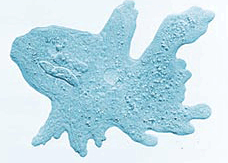My Cart
Your Shopping Cart is currently empty. Use Quick Order or Search to quickly add items to your order!
Mary Haugen
Living Zoology Department
Carolina Biological Supply Company

When you look at a body of water, it is easy to focus on the obvious—birds, fish, plants, and recreational opportunities. However, unseen are microorganisms in the water and the surrounding substrates that you can study in your classroom with ease. Protozoa, a group of 215,000 described species of flagellates, amoebas, spore formers, and ciliates, are excellent tools to help students understand single-celled organisms.
Protozoa can also be found within other organisms, and can be used as examples of symbiosis and mutualism for ecological and entomological studies. Symbiosis is when 2 dissimilar organisms live together in close association, and mutualism is defined as a mutually beneficial relationship between 2 organisms. Sometimes these 2 relationships are combined. For example, the termite exhibits a symbiotic mutualism with the protozoan Trichonympha, which helps it digest cellulose.
Protozoa in the environment can impact human, animal, and plant life. When looking at diseases affecting humans and animals, protozoans of interest are members of the phylum Apicomplexa. Within this group is Plasmodium, a blood-borne pathogen that causes malaria and is transmitted by the Anopheles mosquito. Relatives of this protozoan group also include the Coccidia, whose members are notable for Cryptosporidium and Toxoplasma, which are spread through contact with infected fecal matter. Protozoa have positive impacts, as well. They can provide a source of energy for other organisms, and protozoan interactions with bacterial communities can release compounds into the surrounding soil that help sustain plant life.
Protozoa can be differentiated by their means of locomotion, which include pseudopodia, cilia, or flagella. These methods are used to move the entire organism or as a means for procuring food. Amoeba proteus constantly changes shape as its pseudopodia (false feet) extend from anywhere on its body. Euglena and Volvox move by means of one or more flagella, whiplike structures that move them through their habitat. Stentor, Vorticella, and Paramecium all have cilia, which are short, hairlike structures that move them through the water. (Be sure to have your Protoslo® ready!)
Protozoa reproduce sexually and asexually using binary fission, budding, and conjugation. Paramecium is a good example for illustrating the process of conjugation. With the large array of protozoan cell types, students can see a progression of increasing complexity. They can also compare and contrast protozoan cell features with those of plant, animal, and bacterial cells. This article’s accompanying activity enables students to experience these fascinating microorganisms firsthand. And the opportunities to learn do not stop there; we can help you take your students to a whole new world of single-celled organisms that is literally at their fingertips.